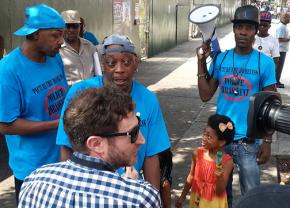East Harlem needs housing
reports on a protest that highlighted the connection between New York City's policing practices and the growing gap between the city's rich and poor.
ONE WEEK after police raided a homeless encampment in East Harlem, about 100 people returned to the scene of the "crime" to demand dignified treatment and guaranteed housing for all--just as a high-profile photo op was taking place in the location where the camp had once stood.
Officers from the NYPD raided the homeless camp at 125th Street and Park Avenue on September 2. They were acting as part of a larger, citywide effort to disperse more than 80 such spaces.
The rally one week later--organized mainly by Picture the Homeless (PTH) in collaboration with Desis Rising Up and Moving (DRUM), Equality for Flatbush and the Committee Against Anti-Asian Violence (CAAAV), among others--began as a speak-out, featuring PTH members, all formerly or currently homeless.
Speaking about the challenges of life on the street, each of the speakers illustrated their daily struggles and outlined alternatives to police intervention in alleviating those struggles. "There will come a time when our kids and our kids' kids will ask: Why didn't you do anything about homelessness when you had the chance?" said PTH co-chair Brodie Enoch. "How is it possible that the police are supposed to protect and serve, but are attacking the most vulnerable?"

From there, a march ensued, looping around parts of East Harlem and stopping in front of the 25th Precinct, as well as unused lots that could--and should--be used for public housing. Speakers repeatedly mentioned the devastation caused by "broken windows" policing--made famous by NYPD Commissioner Bill Bratton--and they explained the connection between the over-policing of people of color and sharpening inequality taking root around the city.
The personas of Bratton and New York Mayor Bill de Blasio loomed large over the event. Speakers regularly invoked how each of them aid and abet the other, saying that "stop-and-frisk has become stop-and-evict." This attitude is a far cry from the media narrative pervasive in the papers, which depicts de Blasio and Bratton as if they are locked in an ongoing feud.
While the terms of interpersonal relationships might remain a mystery, it is clear that their minor disagreements over the flexing of police power in the city don't impact the outcome for the city's homeless population. In the dispute between a huge police presence versus a massive one, the only losers have been the city's poor and working people.
MUCH OF the manufactured outrage over homelessness has, in fact, been spurred on by the city's right-wing media.
The New York Post has covered it incessantly in recent months, most notably with a cover story and multiple days of reporting devoted to one homeless man urinating on the Upper West Side. Instead of advocating for real solutions, the paper has instead pitched the escalating homelessness problem as one of "liberal failure," excessive "tolerance" and not enough police presence.
If going from one homeless man to advocating for a violent, police-led citywide cleanup seems like a leap, there is ample precedent for it. The city has even recently proclaimed, ironically, that it will attempt to clear out large numbers of homeless people in Midtown in anticipation of the Pope's visit.
Bratton has gamely played along with this narrative, using the deteriorating housing situation to wrangle more power for the police. He has done this with the assistance of his old boss, former Mayor Rudolph Giuliani.
Giuliani entered the fray touting his "tough on crime" stance and declaring that de Blasio was "ignorant" for claiming that the shelter population rose 40 percent under Giuliani--Giuliani insists it was “only” 32 percent. He stated that this increase was actually a measure of success. "People in shelters...are not homeless," he said, elegantly making these comments right before a 9/11 memorial ceremony.
For his part, Bratton predictably helped let Giuliani off the hook by pining for the good old days. Speaking about homeless people sitting on the street, he told CBS2: "If you, the citizen, walking down the street can walk around them, then they're not obstructing your free foot passage. The obligation on you is to walk around them. It doesn't seem quite right, but that's the limitation our officers have."
De Blasio, seeking to bolster his own credentials, has downplayed the homelessness issue altogether, attributing the problem to the policies of his predecessors: Giuliani and Michael Bloomberg.
In fact, de Blasio has been building a housing legacy similar to the very conservatives he despises: regular police rousting of the homeless, a focus on luring private wealth into the city that displaces long-time residents, and now the implementation of a plan allowing private developers to pay to take over three New York City Housing Authority sites.
The soap opera of public bickering among city officials obscures a devastating reality for the poorer residents of the city. It has even helped drown out the unsettling news that the city has begun applying CompStat--a controversial system of surveillance and data collection--to the homeless themselves. While Bratton denied this claim, sources say that cops have taken to calling it "Bum-stat."
THE RALLY focused not on the political games, but on real, tangible solutions for the homeless. With chants like "Housing not handcuffs" and frequent encouragement to call or tweet de Blasio directly, the rally didn't shy away from confrontation.
Responding to a question from a reporter about pro-police critics who say de Blasio is "too soft" on the homeless, Enoch replied incredulously, "What does that even mean? Soft on homelessness? He should be hard on homelessness. He should create housing. Maybe they're right. He is soft on homelessness 'cause he's not doing anything about it."
Another notable point for many in attendance was the massive police presence. With a turnout more appropriate for occupied territory, the police lined several streets along the route entirely with patrol cars. At each of the rally's stops, large vans of police slowly rolled by. "You can't make us disappear," said Christopher, a PTH member. A robust appearance by CopWatch, however, kept them at a safe distance.
While the turnout was nearly dwarfed by the cop convoy, the demands were anything but small: a shifting of resources away from police presence and into jobs, schools, and mental-health services; actual affordable housing that is not dependent on the profits of developers; and housing as a human right for all.
In a city of decaying options, it is more vital than ever that demands such as these, as opposed to incremental reforms driven by profit, rise to the top.


